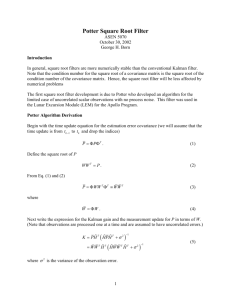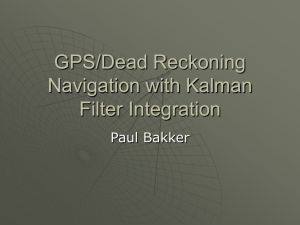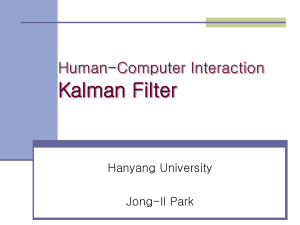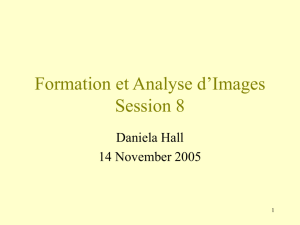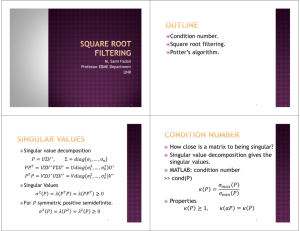Document 10616946
advertisement
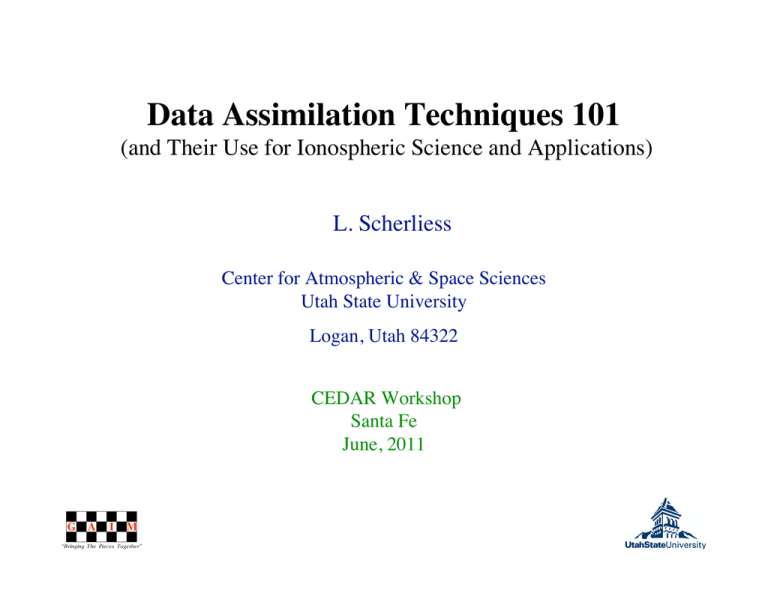
Data Assimilation Techniques 101 (and Their Use for Ionospheric Science and Applications) L. Scherliess Center for Atmospheric & Space Sciences Utah State University Logan, Utah 84322 CEDAR Workshop Santa Fe June, 2011 The Daily Weather Forecast is a Product of Data Assimilation On the One Hand, we have large Quantities of Data Different kinds of instruments measuring different quantities (apples and oranges) Observations are in different places Observations have different cadence and availability Observations statistics have different error http://guvi.jhuapl.edu Difficult to create coherent Picture On the Other Hand, we have Mature Theoretical/Numerical Models Models contain our ‘knowledge’ of the physics Uncertain Parameters in Physics-Based Model • • • • • • O+ - O Collision Frequency Secondary Electron Production Downward Heat Flow Chemical Reaction Rates External Forcing Etc. Objectives Optimally combine Data and the Model to create coherent Picture of the Space Environment Solution satisfies the physical laws and ‘agrees’ with the data and the model as best as possible (within their error bounds) Data Assimilation Tasks Develop Physical Model Develop Assimilation Algorithm Data Acquisition Software Data Quality Control Executive System Validation Software Brief Historical Background Data Assimilation in the Atmosphere: Initial Attemps started in the 1950th (NWP) Data Assimilation in the Oceans: Began with large scales (mean properties) about 30 yrs ago Regional effords (e.g., Gulf stream) [15-20 yrs ago] Produce operational upper ocean now- and forecast. Data Assimilation in Space Sciences Assimilative Mapping of Ionospheric Electrodynamics (AMIE, Richmond and Kamide, 1988) Initial Testing of Kalman Filter for Ionospheric Electron Density Reconstructions (Howe et al., 1998) Data Assimilation Models for the Ionosphere (late 1990): GAIM models, IDA4D Data Assimilation Models for the Thermosphere (Minter et al., Fuller-Rowell et al.) Data Assimilation Initial Attempts for the Radiation Belts for Solar Data Assimilation What can we learn from Meteorology? Data Assimilation Techniques have been used in Meteorology for the last 50 years Most Accurate Specifications and Forecast Models are Those that Assimilate Measurements into a Physics-Based Numerical Model Better Predictions are Obtained for the Atmosphere – When the Data are Assimilated with a Rigorous Mathematical Approach Data Assimilation Techniques 3-d Var T T −1 b o J (δx ) = 1/2δx P δx + 1/2[ H (δx + x ) − y ] R−1 [ H (δx + x b ) − y o ] € 4-d Var n J (δx ) = 1/2δx P δx 0 + 1/2∑ [ H i ( M i,o (x 0 )) − y T 0 −1 i= 0 Kalman Filter € xf = Mx + η Pf = MPMT + Q yo = Hx + ε K = PfHT (HPfHT + R)-1 xa = xf + K(yo - Hxf) Pa = (I-KH)Pf € o T i ] R−1 [ H i ( M i,0 (x 0 )) − y io ] The Data Assimilation Cycle Data Collection Quality Control ‘Best-Guess’ Background Short-Term Forecast Analysis Forecast Physical Model creates a forecast which is adjusted by the Data to create an ‘analysis’, which serves as the start for the next model forecast. In the analysis the Data Errors and Model Errors are used as weights. Fundamental Concept of 3D-Var Start with a forecast or an estimate of the state (background) Data Collection Quality Control ‘Best-Guess’ Background Short-Term € Forecast Analysis Forecast Fundamental Concept of 3D-Var Minimize the difference between the analysis and a weighted combination of the background and the observations. ‘Best-Guess’ Background Short-Term € Forecast Data Collection Quality Control Analysis Forecast The Cost Function To produce the analysis we want to minimize a “Cost Function” J which consists of: J = JB + JO + JC JB: Weighted fit to the background field JO: Weighed fit to the €observations JC: Constraint which can be used to impose physical properties (e.g., analysis should satisfy Maxwell’s equations, continuity equation, …) The Cost Function, cont. A typical form for the JB term is: JB = (xA - xB)T B-1 (xA - xB) Where: xA: Analysis Variable (e.g., Electron Density, Temperature, …) xB: Background Field, obtained from the Model Forecast € B : Background Error Covariance Matrix: • How good is your Background • What are covariances between different elements The background error covariances are only poorly known The Cost Function, cont. A typical form for the cost function for the observations is: JO = [y - H(xA)]T R-1 [y - H(xA)] Where: y : Represents all Observations H : Forward Operator which maps the Grid Point Values to € Observations (can be linear or nonlinear) R : Observation Error Covariance Matrix: How good is your data? (also includes the representativeness of the data) The Cost Function, cont. The Physical Properties/Model were used to: Obtain the best possible background field To constrain the Analysis Cost function and the constraints are not explicitly time dependent € A temporal model is not necessarily required Snapshots Fundamental Concepts of 4D-Var 4D-Var introduces the temporal dimension to data assimilation Find a close fit to the data that is consistent with the dynamical model over an extended period of time. Find the the closest trajectory n T J (δx ) = 1/2δx P δx 0 + 1/2∑ [ H€i ( M i,o (x 0 )) − y io ] R−1 [ H i ( M i,0 (x 0 )) − y io ] T 0 −1 i= 0 € The Model The Data Fundamental Concepts of 4D-Var 4D-Var introduces the temporal dimension to data assimilation Find a close fit to the data that is consistent with the dynamical model over an extended period of time. Find the the closest trajectory n T J (δx ) = 1/2δx P δx 0 + 1/2∑ [ H€i ( M i,o (x 0 )) − y io ] R−1 [ H i ( M i,0 (x 0 )) − y io ] T 0 −1 i= 0 € Model Error Covariance Data Error Covariance M - State Transition Matrix P - Model Error Covariance y - Data Vector R - Observation Error Covariance X - Model State Vector η - Transition Model Error Q - Transition Model Error Covariance H - Measurement Matrix ε - Observation Error K - Kalman Gain Model Error Covariance Data Error Covariance M - State Transition Matrix P - Model Error Covariance y - Data Vector R - Observation Error Covariance X - Model State Vector η - Transition Model Error Q - Transition Model Error Covariance H - Measurement Matrix ε - Observation Error K - Kalman Gain Model Model The Dynamical Model entered the Filter: Evolution of the State Vector (make a Forecast) Evolution of the Error Covariance Matrix Model The Dynamical Model entered the Filter: Evolution of the State Vector (make a Forecast) Evolution of the Error Covariance Matrix Error Covariance Matrix becomes time-dependent and evolves with the same physical model as the state! This is computationally the most expensive step in the Kalman filter Example: Tracking of a Rocket with a Kalman Filter A rocket is flying through space launched from an initial location with an initial velocity. d2x m 2 = ma dt € € ⇒ dx =v dt dv =a dt € ⇒ x i+1 ≈ x i + v i ⋅ dt ⇒ v i+1 ≈ v i + ai ⋅ dt ⇒ ai+1 ≈ ai €: x = M x In Kalman filter we have i+1 i € € x i+1 1 dt v i+1 = 0 1 € ai+1 0 0 0 x i dt v i 1 ai Example: Tracking of a Rocket with a Kalman Filter Propagate Error Covariance Matrix: Pi+1 = M Pi M T σ x2 0 0 € 2 P0 = 0 σ v 0 2 0 0 σ a At the next time step: 1 dt € P1 = 0 1 0 0 2 0 σx 0 0 1 2 dt 0 σ v 0 dt 2 1 0 0 σ a 0 0 0 1 0 dt 1 Example: Tracking of a Rocket with a Kalman Filter Propagate Error Covariance Matrix: Pi+1 = M Pi M T σ x2 0 0 € 2 P0 = 0 σ v 0 2 0 0 σ a At the next time step: σ x2 + σ v2 dt 2 σ v2 dt 0 € 2 2 2 2 2 P1 = σ v dt σ v + σ a dt σ a dt 2 2 0 σ a dt σa The Rocket Position Velocity Acceleration Kalman Filter has specified the external Forcing Forcing is specified based on the Dynamics provide by the physical Model Next, consider the more complicated situation: Much more complicated Differential Equations Global Many Reconstruction observations Different kinds of instruments measuring different quantities Observations are in different places This is the Situation in the Ionosphere Model This is computationally the most expensive step in the Kalman filter Ways to get around the Problem Approximate Kalman Filters • Band-Limited Kalman Filter • Reduced State Kalman Filter • Gauss-Markov Kalman Filter • Ensemble Kalman Filter Do not evolve Error Covariance Matrix with Model INSTEAD Obtain Error Covariance Matrix from an ENSEMBLE of Model runs Gauss-Markov Kalman Filter Model (GAIM-GM) Specification & Forecast of the Global Ionosphere • Ionospheric Forecast Model provides background densities • Kalman filter solves for derivations from the background • Uses simple statistical model instead of full physics • Error covariances are calculated from 1104 IFM model runs • Assimilates 5 data types: • Slant TEC from ground-based GPS receivers • Bottomside Ne Profiles from Ionosondes • UV radiances (1356Å and 911Å) • DMSP IES in situ Ne • Slant TEC from COSMIC GAIM-GM Model Run for November 20, 2003 Storm GAIM Specification of TEC Distribution Illustration of Locations of GPS/TEC Data. Slant TEC Values have been mapped to the Vertical Direction GAIM Specification of TEC Distribution Illustration of Locations of GPS/TEC Data. Slant TEC Values have been mapped to the Vertical Direction Full Physics Kalman Filter Model • Ensemble Kalman Filter 30 Global Simulations are Launched at Each Assimilation Time Step • Physics-based Ionosphere-Plasmasphere Model • Model Physics is embedded in Kalman filter • Same 5 Data Sources as Gauss-Markov Model • Provides both specifications for the ionospheric plasma densities and drivers. Determination of Ionospheric Drivers Using The Full Physics-Based GAIM Model Ionospheric Sensitivities to Drivers are embedded in the Covariances and are automatically and at each Time Step calculated. Drivers include: • Electric Fields • Neutral Wind • Composition • … Example of Full Physics-Based Kalman Filter Model • Several Days in March/April of 2004 • Geomagnetically Quiet Period • Data Assimilated o Slant TEC from 162 GPS Ground Receivers • Use Ionosonde Data for Validation Comparison with Ionosonde Data Ionosonde Data were NOT assimilated! Data Issues • Are There Enough Data? • What is the Data Quality? • Are Error Estimates Available? • Are Data Available in Real Time? • Are Different Data Types Required? Missing Physics How Does Missing or Incomplete Physics Affect the Data Assimilation Results? • Simulate the Ionosphere with the IPM • Modify the Simulated Ionosphere to Account for Missing Physics • Generate Synthetic Data from Real Locations • Reconstruct the Ionosphere with the Gauss-Markov Data Assimilation Model • Compare Reconstructed Ionosphere with Original Ionosphere Ionosphere That Produced Synthetic Data Four Bubbles Gauss-Markov Reconstruction With Synthetic Data Results Look Reasonable, but are Wrong Summary

